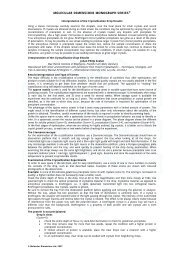(IEA Energy Papers 2011_05) Matthias Finkenrath-Cost and Performance of Carbon Dioxide Capture from Power Generation (IEA Energy Papers)-OECD Publishing (2011)
You also want an ePaper? Increase the reach of your titles
YUMPU automatically turns print PDFs into web optimized ePapers that Google loves.
<strong>Cost</strong> <strong>and</strong> <strong>Performance</strong> <strong>of</strong> <strong>Carbon</strong> <strong>Dioxide</strong> <strong>Capture</strong> <strong>from</strong> <strong>Power</strong> <strong>Generation</strong> ©<strong>OECD</strong>/<strong>IEA</strong> <strong>2011</strong><br />
<strong>Cost</strong> <strong>and</strong> performance results <strong>and</strong> discussion<br />
Page | 22<br />
In this working paper cost <strong>and</strong> performance data for CO 2 capture <strong>from</strong> power generation are<br />
reviewed, recalibrated <strong>and</strong> updated to 2010 cost levels. The results <strong>of</strong> this analysis are presented<br />
<strong>and</strong> discussed in this chapter.<br />
Main case studies<br />
Only CO 2 capture cases that are covered by several studies are included in this report. The<br />
evaluation <strong>of</strong> coal‐fired power generation focuses on post‐ <strong>and</strong> oxy‐combustion CO 2 capture <strong>from</strong><br />
supercritical (SCPC) <strong>and</strong> ultra‐supercritical pulverised coal (USCPC) boilers as well as precombustion<br />
CO 2 capture <strong>from</strong> integrated gasification combined cycles (IGCC). Post‐combustion<br />
CO 2 capture is also analysed for natural gas combined cycles (NGCC). 6<br />
Hence, results for four main CO 2 capture cases are presented:<br />
Post‐combustion CO 2 capture <strong>from</strong> coal‐fired power generation using amines<br />
Pre‐combustion CO 2 capture <strong>from</strong> integrated gasification combined cycles<br />
Oxy‐combustion CO 2 capture <strong>from</strong> pulverised coal power generation<br />
Post‐combustion CO 2 capture <strong>from</strong> natural gas combined cycles<br />
Post‐combustion CO 2 capture using ammonia is a potential near‐term alternative to amine‐based<br />
solvents. A similarly detailed analysis is not possible for ammonia‐based solvents since only few<br />
related data are presented in the analysed studies. Available data are nonetheless listed in the<br />
Annex <strong>of</strong> this working paper for reference.<br />
Biomass‐fired power generation with CO 2 capture is not evaluated in depth since information is<br />
rare compared to coal‐ <strong>and</strong> natural gas‐fired plants. A single data point for post‐combustion<br />
capture <strong>from</strong> coal‐fired power plants with 10% co‐firing <strong>of</strong> biomass is however added in the<br />
results presented in this chapter for comparison.<br />
As outlined above, results report cost <strong>and</strong> performance estimates for new‐build, early<br />
commercial plants. All cost data, including LCOE <strong>and</strong> cost <strong>of</strong> CO 2 avoided, cover costs related to<br />
the capture <strong>and</strong> compression <strong>of</strong> CO 2 to supercritical pressures, as well as the conditioning <strong>of</strong> CO 2<br />
for transportation (but not for CO 2 transport <strong>and</strong> storage). Generally, CO 2 capture costs are<br />
considered to represent the bulk <strong>of</strong> the costs <strong>of</strong> integrated CCS projects. CO 2 transport <strong>and</strong><br />
storage costs can still be significant depending on the local availability <strong>and</strong> characteristics <strong>of</strong><br />
storage sites, <strong>and</strong> are thus crucial additional economic factors to consider in any project‐specific<br />
evaluation or energy scenario modelling work.<br />
To illustrate cost <strong>and</strong> technology development trends, CO 2 capture data shown in the following<br />
tables <strong>and</strong> figures are sorted by the year <strong>of</strong> the cost information as provided in the original<br />
publication. Key data are shown for reference cases with (w/) CO 2 capture <strong>and</strong> without (w/o) CO 2<br />
capture. <strong>Cost</strong> <strong>of</strong> CO 2 avoided is a useful metric for comparing economics <strong>of</strong> a specific CO 2 capture<br />
process against alternative CO 2 capture technologies. An appropriate reference case without CO 2<br />
capture needs to be chosen for specific assessments. In a specific new‐build CCS project, this<br />
reference would be the most economical power generation alternative without CCS that meets<br />
all project‐specific requirements (e.g. regarding plant availability or operating flexibility). This<br />
6 Across reviewed studies, only a single case is available for each pre‐ <strong>and</strong> oxy‐combustion capture <strong>from</strong> NGCC; thus,<br />
these capture routes are not included in this review.




